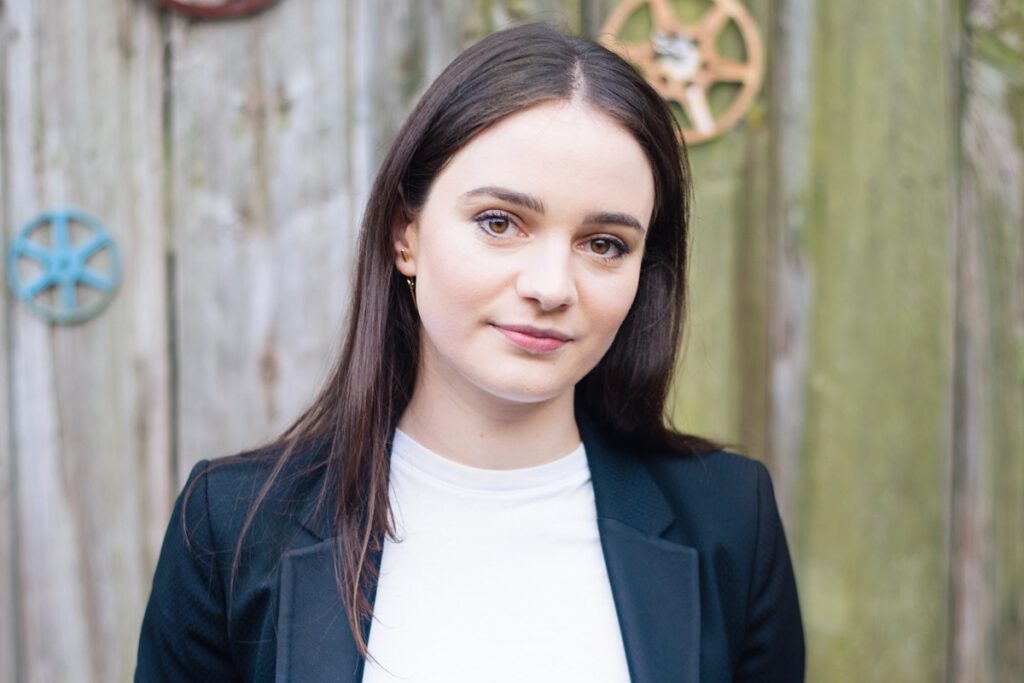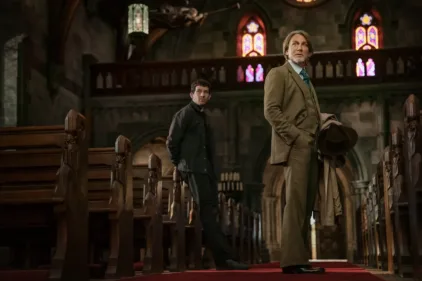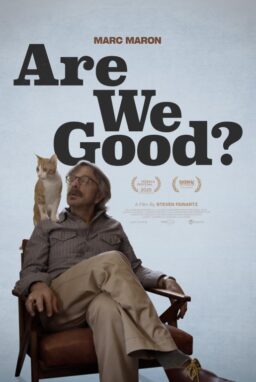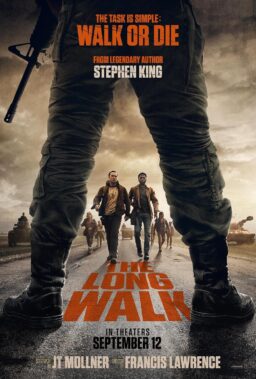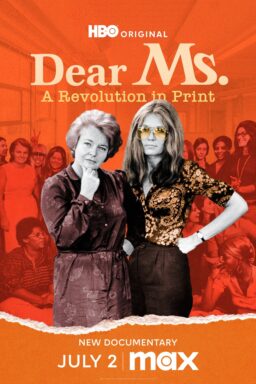As soon as “The Nightingale” begins, you know you are in the hands of a master filmmaker. You sense that something dire is about to occur, yet not sure where or how the threat will arrive, placing you perpetually on the edge of your seat, with your eyes peeking from beneath your fingers. The enormous promise that Australian writer/director Jennifer Kent exuded in her startling 2014 feature filmmaking debut, “The Babadook,” comes to a full bloom in this brilliantly crafted sophomore effort, a breathtakingly tragic yet affirmative fable for the ages. Aisling Franciosi, the Irish-Italian actress known to “Game of Thrones” fans as Lyanna Stark, delivers one of the year’s very best performances as Clare, an Irish convict who submits to the abuse of a British soldier, Hawkins (played in a monstrous turn by Sam Claflin), in order to protect her husband, Aidan (Michael Sheasby), and baby.
When her dreams for a better future are shattered by a devastating act of violence committed by Hawkins and two henchmen, Jago (Harry Greenwood) and Ruse (Damon Herriman, currently playing Charles Manson in Quentin Tarantino’s “Once Upon a Time…in Hollywood” and on Netflix’s “Mindhunter”), Clare embarks on a single-minded pursuit of vengeance through the wilderness of Tasmania. Before setting out, she orders an Aboriginal tracker, Billy (Baykali Ganambarr), to offer his assistance, and it is the shared understanding that gradually forms between them that emerges as the heart of the film. Kent’s portrayal of nightmare sequences are unlike any I’ve seen. They trigger the same sort of visceral dread one feels right before lurching up in bed, though it is the horrors that Clare observes when conscious that are guaranteed to keep audiences up at night. The film screened this past May at the Chicago Critics Film Festival on the same evening that the “Game of Thrones” finale aired on HBO, and though there were a handful of walk-outs, the audience members I spoke to who stayed were left exhilarated by the experience.
The next morning, I spoke with Franciosi about her collaboration with Kent, and our conversation proved to be a therapeutic one. Since spoilers are mentioned in the answers below, I recommend that you read them after seeing the film, which is surely among the year’s finest and most vital cinematic achievements. Kent has come under fire for tackling such disquieting subject matter, prompting a journalist to hurl a sexist slur at her when the film premiered last fall in Venice. Yet her film is the very opposite of exploitation, taking an unflinching look at the ramifications of evil acts while illustrating the healing power of human connection in a way that is bereft of contrivance or condescension (the participation of Aboriginal elder Jim Everett as an associate producer and consultant should also be singled out). At a time when women’s voices are finally being heard when opening up about issues of abuse, “The Nightingale” provides essential context to the conversation. It is a film that is impossible to shake, and for good reason.
The pre-title sequence in “The Nightingale” is evocative of the ending in Kubrick’s “Paths of Glory,” where a German girl is brought before soldiers who catcall her until she begins to sing, and she reduces them to tears. Both films suggest that music can serve as a humanizing force.
It absolutely does. It’s usually a form of storytelling in itself. Certainly in the sean-nós style, which is the old Irish style of singing, there’s always a story in there. Billy has his songs and Clare has her’s, and we find both characters at a moment when they are firm in their identity. Clare is insisting that she’s “not f—king English,” while he’s telling her, “You don’t know about me, my history or my people.” Songs are really a stamp of identity for them, but one that clearly is a tie. It’s like a human tie. Music doesn’t need to have words to be moving as well. It’s a way of communicating with others that crosses language and ethnicity and everything. I think that it’s really a powerful, unifying thing.
I admired how this film avoids the patronizing clichés of other interracial friendships we’ve seen onscreen, which are often viewed through a white lens. The bond between Clare and Billy is forged when they see themselves reflected in each other’s stories.
Jen was hyper-aware of not wanting to fall into those tropes, particularly in regards to the portrayal of an aboriginal character. Being a white woman herself, she was careful about ensuring that this film never fell into the category of a white savior story. I think it’s very clear that Billy is Clare’s savior, though he’s not perfect, and neither is she. Her racism demonstrates that she’s a product of her time. You’re right that they see the trauma in each other’s stories, but it’s only when they pause a second and stop berating each other. Then they actually hear what the other is saying, and I think that is part of what we are trying to say with this film.
Clare thinks she knows better than Billy. She’s like, “I’m going this way, I’m killing this dude,” and none of it works for her. It just makes her unravel even more, and it’s Billy’s basic human respect that kind of helps her save herself. She realizes that she can’t go down that road because it’s worse than she had imagined. Clare decides to save herself by staying true to her humanity. I think it’s important that she observes Billy’s humanity in his knowledge and respect for the land, as well as the way that he deals with animals when he and Clare are invited for dinner. All of that had to be more powerful, I think, in guiding her than anything else because she probably would’ve died in a day if she hadn’t had him.

How would you contrast staging your intimate scenes with Jamie Dornan on BBC’s “The Fall” with those involving Sam Claflin here, in terms of how trust and staging play an essential role in maintaining a safe work environment?
It was a bit different. There were intimate scenes with tricky material that Jamie and I performed together, but Clare’s story just brought on a whole new level of importance and responsibility for me. I wanted to get to a point where I could be the most vulnerable version of myself, and I definitely could not have done that without knowing Sam the way that I do. With “The Fall,” I guess it was different because nothing actually happened between the characters that Jamie and I played. Of course, we were in close proximity, but there was also a lot of joking around onset. It was a different atmosphere, and not because the material wasn’t as serious. After all, Jamie was playing a serial killer, and there’s the threat of abuse in his scenes with my character, but in the case of this film, there are so many layers of it that are historically accurate.
Clare and Billy’s story is not a historical account, but it is based very much on a truthful setting. It’s kind of difficult on those days when you are dealing with depictions of violence that has happened to so many women, and is still happening around the world. People’s babies are being killed, and on top of that, the film’s racial element is equally timely. When we filmed the scenes of sexual violence in “The Nightingale,” it was a pretty somber atmosphere on those days. I totally believe there is a place for humor in alleviating heaviness and tragedy onset, but particularly because I had met real victims, and the people who work with them, such as social workers, I couldn’t get that reality out of my head.
I was like, “I cannot indulge in any niceties today.” It just would’ve felt out of place, and I also felt like I would’ve been disrespecting all the people who had helped me with sharing their stories and getting me to this place. The actors, of course, were so lovely and supportive, and our crew—I always love crews—but our crew in Australia was so sensitive to the material, and we became really close. It’s lucky that we filmed those scenes early on in the shoot because one of the crew members later said to me, “If we had known you then as well as we do know, I don’t think I could’ve stayed shooting that scene in that room.”
When Clare explains to Billy that the men she’s pursuing “stole something” from her, I was reminded of testimonials from survivors of abuse, who speak about the importance of reclaiming the power and sexuality that has been robbed from them.
When she says, “They stole something from me,” she’s using it to justify Billy coming with her, but really what she wants to say is, “They stole everything from me.” She can’t bring herself to say that they stole everything from her, because otherwise, why is she going on this quest in the first place? It’s a weird, two-sided thing in that she had to lose literally everything in order to be able to go after Hawkins in that way. At the same time, if she had stopped for even two minutes to acknowledge and really feel what had happened to her, she would’ve been completely destroyed. I actually talked about it with a psychologist, Dr. Elaine, who said, “It’s really important that Clare never lets herself fully feel her emotions because if she were to do that in real life, she would just crumble. She would just probably fall down and want to die.”
As part of my research for the role, I also spent time with new mothers and their babies, partly so I would be used to having one on my hip all the time. [laughs] I also wanted to talk to mothers, and one of the things I said to them was, “I know this is a horrible thing to think about, but if someone did something to your child, what would you so?” And without fail, every single one of them was like, “I’d kill them,” and they said it with such intensity. But you’re right about that line. It wasn’t just about her family and her baby. Clare’s also speaking about her future, her sense of self, and as you say, her sexuality as well. For me, the saddest loss is this future that she had endured so much to protect, and now, not only is it taken away from her, but that endurance was for nothing.
Regarding the distinction that we make between sexual violence and violence itself, it’s important that we emphasize the fact that rape is violence. There is a reason why rape and war go hand in hand. It is an extremely powerful, dehumanizing, destructive weapon that has really long-lasting effects. You are left with grief and trauma that still must be dealt with long after the violence has occurred. I’m not saying, of course, that death isn’t horrific as well, but I feel like violent rape is an attempt to destroy someone without actually destroying them in a physical sense. You are destroying their sense of self without killing them. So yes, that line has so many layers to it.
How did you go about choreographing the killing of Jago, the young soldier present during the film’s inciting incident? It is truly the most agonizing depiction of the difficulty in murdering a human being that I’ve seen since Hitchcock’s “Torn Curtain.”
One thing that I used quite a lot during the film is a technique that I discovered during my two-and-a-half hour callback. I realized that I needed to go outside. I ran around and found out that movement, for me, is really important for bringing up emotions.
Helps with my writing too.
That’s so interesting! I told Jen this, and she organized classes for me so I could be fit, and there was also a stuntman on set who would help me out. Jen would say, “Do you need to go out for a few minutes before we shoot this scene?” I’d say, “Yeah,” and then I’d leave with the stuntman. He’d hold up boxing pads, I’d get the gloves on and then just beat the hell out of the pads before shooting. Harry is six foot something, he is a huge dude, so we obviously had to make sure that we were safe. We had a fake musket that we could use in place of the real one, which is incredibly heavy. I really would’ve done some damage if I had gotten the movement wrong with the real musket. We were exhausted after filming that scene. I loved that not only, as you said, it takes Clare so long to accomplish her task, but there are many attempts that keep failing.
Apart from the fact that I really like Harry—he is one of the sweetest people you could meet—what makes this killing so difficult is that it really goes against Clare’s nature. Obviously, there’s that maternal fury that is coming through for wanting to get back at someone who would enable such an unthinkable act to happen, but I think people probably underestimate how difficult it really is to kill someone, not just in the physical act of doing it, but in that it goes against our very nature. I find Jago’s death really sad, because he is someone who, in the heat of the moment, was terrified by Hawkins and did something in a split second that haunts him for the rest of the film, until he meets his demise.
Choreographing the actual stabbing was interesting because Jen was like, “It’s really hard if you hit the chest bone.” [laughs] She was very particular. When we turned the camera around and filmed Clare coming down on Jago with the gun, we used the real musket. My god, it was so heavy, and the next day, my shoulders killed me. As technical as I had to be during a scene like this, Jen still manages to hold onto—on set, in the shooting environment—this very intimate feeling. Harry and I were so emotionally involved in the scene that we became really upset, and I think that is a testament to Jen. She is a brilliant actor’s director. Story and performance are the things that matter the absolute most to her. She wants to create an environment that will allow you to get to your best performance. Sometimes she pushed us to our absolute limits, but I think that it was worth it.
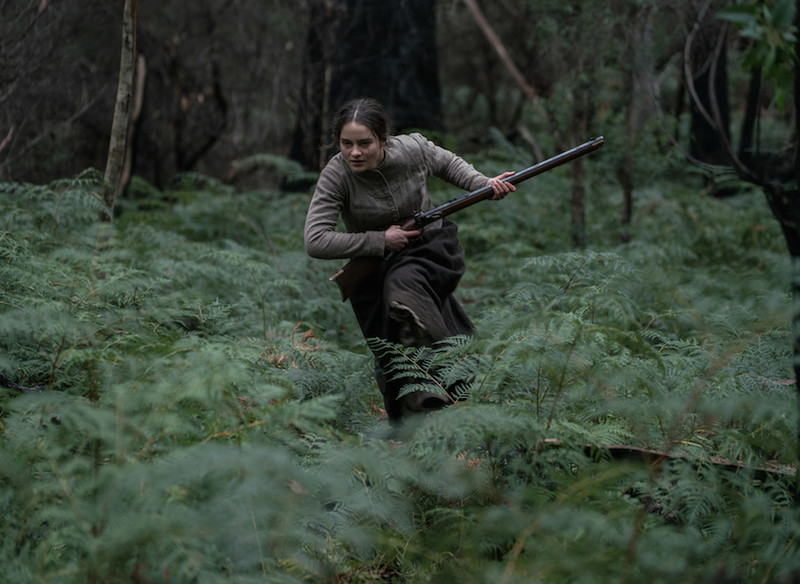
The use of the close-up is essential in containing us within Clare’s moment-to-moment experiences, such as when her face transforms from fear to ferocity as she goes to confront Hawkins, or during the shared look between Clare and Billy, where they stare directly at us.
That’s actually why Jen said from the beginning that she wanted to shoot “The Nightingale” in the Academy ratio [1.37:1]. She felt that it was brilliant for faces. Her idea was that she wanted to still capture the beauty of the environment without reducing us to little dots. This film is about the human side of pain and violence, so it is really important that the characters are right up close with the audience, not just with the beautiful scenes where Clare and Billy are finally looking at each other, but also in the horrific scenes of sexual violence. The camera is right up there in our faces, because we don’t want viewers to get away from the emotional side of it. It’s not a physical thing that we want you to see, we want you to see the emotional pain. I loved the fact that we were using so many close-ups because it helped the performers in letting go. You don’t have to worry too much about the technicality of how wide the angles may be.
When you know you are in close-up, you know that the camera is going to be getting everything, so you just have to think and feel and be in the moment. When we were filming with the horse, there were times when we’d be asked to move two inches to the left, but for the most part, we didn’t have to worry about any of that. It was really liberating, and that approach formed a strange juxtaposition with these huge landscapes. Part of you would think that you would have to do everything bigger in such a setting, but then to have the focus so narrowed down on your face, I found it freeing. I had to think way less about how I was being filmed. I just had to be Clare, and I knew that they would get whatever they needed. We had this joke on the set about my favorite lens being 75 anamorphic. I’d be like [in diva voice], “75 anamorphic?” Jen would reply, “No, not this time,” and I’d go, “Awww…” [laughs]
You made your big screen debut with another master filmmaker, Ken Loach, in 2014’s “Jimmy’s Hall.” Did you find any through-lines between him and Kent?
There were definitely some similarities in terms of research. It is so much fun making a Ken Loach film. I got to go down to our location in Ireland two months beforehand, and we learned the dances of the Depression-era period where the film was set. We don’t get a script, so the only thing that we could do was improvise as a group. That made it all the more imperative that we learned about the historical context and the politics of the time, and Jen did a lot of that too. We had a script for “The Nightingale,” but we never rehearsed a scene. We only ever did workshopping or improvising, so that was one similarity. In terms of actual shooting style, Ken and Jen are very different. It’s always so fascinating to me how people can have such a clear vision but achieve it in a totally different way.
With Ken, I sometimes wouldn’t even know where the camera was. He’d come in, and he never said action. He’d be like, “Off you go,” and we’d often improv into a scene to get to the lines that we were saying, whereas Jen was absolutely clear about what she wanted, down to if there was a bit of sunshine in the back of the shot. She’d be like, “No, no, stop, we have to wait for a cloud.” There was a bit more of an element of realism in Ken’s film, and because he filmed everything chronologically, he didn’t mind if the weather changed from one minute to the next because that’s what happens in Ireland. With Jen’s film, literally every frame of it was so clear in her mind. She’s a perfectionist, and very meticulous in how she works. They both created very good working environments for the actors, which is probably one of the most important things a director can do.
Kent believes that empathy is the last hope for mankind’s salvation, and I can’t help agreeing. Is that an important quality for you to locate when considering a project?
Yes, and they’re actually not as easy to find as you’d think. Don’t get me wrong, I’ve always had a wild imagination, so I do love genres like fantasy, but the thing that I am most fascinated by is human interaction—the way that we can be both so horrific to each other and so wonderful at times. I love exploring what it is that really makes us human, and how we are actually so much more similar than we are different, yet we continue to not want to see that. “The Nightingale” is obviously a very dramatic story, but I love the human element in it. Jen has this epic tale focus, as you say, very much on a face or faces, which allows it to pinpoint the humanity in the characters, and I love that. I think Ken’s films do the same thing. They’re very human stories, and that strips back everything else, enabling us to examine how we can get past being so awful to another, and what the violence is all for. A story will interest me if its characters feel real, and there are very human characters that can be found even in the worlds of fantasy. As soon as I see truth on a page, I’m like, “I’m in!”
It was an honor that you chose to attend our festival screening last night, rather than stay in and watch the “Game of Thrones” finale. Have you gotten to see it yet?
I have not, though I know what happened because it’s impossible not to. I think when people will look back at the pop culture of this era, “Game of Thrones” will stand as a huge epic that sparked many important conversations throughout its seasons. I can’t imagine what it must be like for the actors who were in it from the beginning to realize that it’s over. It’s such an end of an era. What I love about the show so much is exactly what you said—last night. Even as binge-watching has become popularized, there is still a show that everyone tunes into on a Sunday or Monday night, or whatever it is in different parts of the world. Then everyone goes back to college or work the next day, and talks about it with their friends and colleagues, and I love that. It creates this sense of community where everyone is gathering to hear the next part of a story.
Obviously there have been TV shows throughout history where everybody tuned in at the same time, but for me, this sort of narrative harkens back to the stories that were told before television, where everyone shared in the communal experience of storytelling. C.S. Lewis said, “We read to know we’re not alone,” and with TV and film, it’s the same thing. You want to find yourself in these characters, even if they differ from you in so many ways. Storytelling is one of the loveliest parts of human nature. It’s often used as entertainment, but it can also be really powerful, and make us look at things in society that we probably have been slow to realize.
Photo: Chicago Critics Film Festival/Deirdre Hayes

